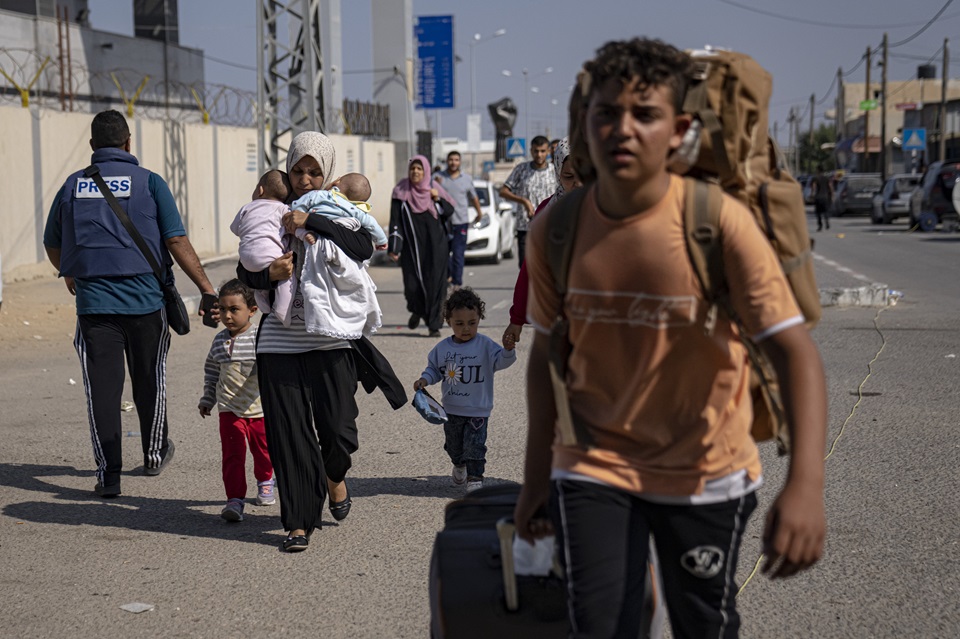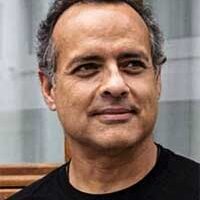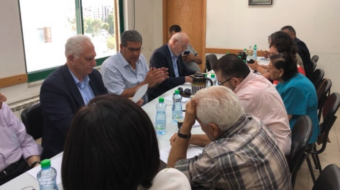
On Oct. 30, 2023, Israeli authorities said that they had killed “dozens” of Hamas fighters in the first days of their ground invasion.
Meanwhile, Gaza’s Ministry of Health has struggled to keep its website online given the lack of electricity, internet, and attacks. Nonetheless, as of Nov. 2, the Ministry of Health said that the death toll in Gaza is now 9,061, with 3,760 of those being children and 2,326 women. Over 32,000 have been injured.
For those who doubt the numbers, the Ministry of Health has been releasing lists of the dead with their Israeli identification numbers. It is a sign of the occupation of the Palestinians of Gaza that when they are born, they must be registered not by the Palestinian Authority but by Israel.
Save the Children says that more children have been killed by Israeli bombing over these three weeks than have been killed in total across all conflict zones since 2019.
The U.N. Relief and Works Agency for Palestine Refugees in the Near East (UNRWA) said that by Sunday, Oct. 29, 1.4 million Palestinians out of 2.3 million were internally displaced, with 671,000 taking shelter in 150 UNRWA facilities.
War on the innocent
Most of the dead by Israeli bombs and tank shells have been civilians.
The ratio of dead between combatants (few) and civilians (many) is startling, far beyond what takes place in a war (in contrast, of the 1,400 Israelis killed on Oct. 7 by Hamas and other factions, 48.4% were soldiers).
By saying that they have killed “dozens” of Hamas militants—the purported target—and having at the same time killed thousands of Palestinians, the Israeli authorities have admitted to the world that their war has resulted in far more civilian deaths than combatant deaths.
Meanwhile, the Israeli military has sent its bulldozers to destroy homes and businesses in northern Gaza as well as in the West Bank city of Jenin. Little in this maneuver looks like a military operation, since these homes and businesses are not military institutions.
Given the history of the bulldozing of housing in the West Bank to create settlements and the “apartheid wall,” this bulldozing in Gaza and Jenin appears like a massive civilizational campaign of ethnic cleansing to create what the Israeli political class calls “Greater Israel” (Eretz Yisrael Hashlema).
The Israeli political class is famous for saying that they want to change the “facts on the ground” so that any negotiations with the occupied Palestinians are based on those “facts” and not on “claims.”
This is what Israeli Prime Minister Benjamin Netanyahu has been doing for decades through illegal settlements in the West Bank: erasing the fact of Palestinian claims on their land and establishing the right of Israelis to the entire landmass from the Jordan River to the Mediterranean Sea.
Effectively, the Israeli political class appears to be using the conflict that began on Oct. 7 as the pretext to do what it had planned to do for decades, namely, to erase Palestinians from historical Palestine and to erase the Palestinian nation as an entity.
One-state, two-state, three-state?
When Palestinian political forces agreed to a “peace process” that resulted in the Cairo Interim Agreement (1994) and the Oslo Accords (1994), it adopted what was known as the “two-state solution” to the Israeli occupation of Palestine.
The basic outline of the Oslo Accords was that a Palestinian Authority (PA) would govern the territory seized by Israel in 1967 (East Jerusalem, Gaza, and the West Bank).
The Oslo Accords, argued Gaza-based Professor Haider Eid, created a “Bantustan” (such as the “African homelands” created by apartheid South Africa).
The implication of the establishment of the PA was that it would neuter actual Palestinian claims to the land (including the right of return of Palestinian refugees, established by U.N. Resolution 194 in 1948), and—at the same time—it would allow the Israeli state to change the “facts on the ground” by the creation of more and more illegal settlements.
Furthermore, after the Second Intifada (2000-05), Israel cut off the “safe passage” requirement of Oslo that allowed Palestinians in East Jerusalem, Gaza, and the West Bank to travel across these zones.
By 2005, Israel had annulled the Oslo Accords, although the Palestinian political class remained bound by them as the only sliver of hope for the establishment of the state of Palestine (even if it would be a small fragment of historical Palestine).
The reality of the “two-state solution” disappeared as the settlements increased in the West Bank, as Palestinian control over East Jerusalem was increasingly absorbed by Israel, as the right to return was set aside, and as Gaza was bombed almost every year.
In that context, several important Palestinian intellectuals began to raise the question of the “one-state solution,” with one Israeli-Palestinian state based on a non-ethnic, secular, and democratic idea of citizenship.
By 2021, a majority of scholars of the region said that the actual facts show Israel to be “a one-state reality akin to apartheid.” The idea that Israel is an apartheid state is now well-established in United Nations documents and human rights reports.
This assessment demonstrates two things: first, that Israel and the Occupied Palestinian Territory are already “one state,” and second, that it is an apartheid state with the Palestinians in a second-class category. Advocates of the “one-state solution” argue that the reality of a singular state now requires equal citizenship for all who live in Israel/Palestine.
The current Israeli political class refuses to accept the idea of a democratic and secular one-state, because they are wedded to an ethno-nationalist project of a “Jewish state” that erases the possibility of full citizenship for Palestinian Christians and Muslims.
If the “two-state solution” is no longer practical and if the “one-state solution” is blocked by the Israeli political class, then all that remains for Netanyahu and others is the “three-state solution.”
This is the solution that seeks to remove large parts of the Palestinian population from East Jerusalem, Gaza, the West Bank and perhaps even from within Israel’s 1948 lines, and send them to the three states of Egypt, Jordan, and Lebanon.
The bulldozers coming behind the tanks in Gaza are attempting to push the Palestinian refugees through the Rafah Crossing into Egypt’s Sinai peninsula (70% of them are descendants of those sent to Gaza in the Nakba, or “Catastrophe,” of 1948).
This “three-state solution” is precisely ethnic cleansing, a crime under international law.
For decades, the Israeli political class has been willing to conduct genocidal policies—including this bombardment of Gaza—to facilitate its ethno-national, apartheid state project that requires the erasure of Palestinians and Palestine.
In 2014, in the aftermath of Israel’s Operation Protective Edge, the Office of the Prosecutor of the International Criminal Court (ICC) opened an investigation into the situation in Palestine.
Nothing much came of this investigation. During this current attack on Gaza, the prosecutor, Karim AA Khan, went to the Rafah Crossing and said that Israel’s blockade of humanitarian aid into Gaza may be a crime under ICC jurisdiction.
Indeed, the fact of apartheid is already a crime under the 2002 Rome Statute that created the ICC.
Both the “one-state reality akin to apartheid” and the “three-state solution” of ethnic cleansing are serious crimes that require investigation.
Will Khan ask the judges of the ICC to frame arrest warrants against Israeli Prime Minister Benjamin Netanyahu and his colleagues?
This article was produced by Globetrotter and republished from peoplesdispatch.org.
We hope you appreciated this article. At People’s World, we believe news and information should be free and accessible to all, but we need your help. Our journalism is free of corporate influence and paywalls because we are totally reader-supported. Only you, our readers and supporters, make this possible. If you enjoy reading People’s World and the stories we bring you, please support our work by donating or becoming a monthly sustainer today. Thank you!












Comments